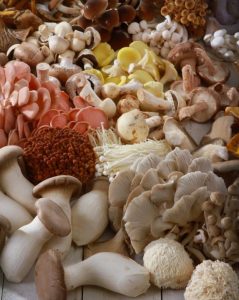At Willow Haven Farm, we believe in the power of real, organic food and the freedom to choose what nourishes us.
This week, we’re sharing some exciting ways to bring local organic beverages into your meals. From adding a cherry wine reduction to meats to mixing up a refreshing ginger apple spritz, these simple ingredients will help elevate your dishes while supporting the local community that grows them.
Join us as we prepare for the season ahead, plant for future harvests, and celebrate the flavors of the land around us. Whether you’re looking to try a new marinade or a fun mocktail, there’s always something fresh to explore here at Willow Haven.
FEATURED: Beverage Sale
This week and next week, we’re featuring several beverages for you. Take this opportunity to try something new!
- Are you ready to try our WHF raw milk? Now is a great time!
- If you haven’t enjoyed artisanal, local wine or spirits, you are in for a delicious, locally-produced treat!
- Learn how to incorporate a variety of beverages into your cooking – see below for recipe ideas and suggestions.
Want to learn to mix your own cocktails and mocktails? We have ingredients and recipe ideas for you. Try this Versatile Cocktail and Mocktail Formula to get you started.
MEAL IDEAS FOR YOUR LOCAL ORGANIC FOOD THIS WEEK:
Many of these recipes include produce or other items you may have received in your market box. You may also see ingredients you can purchase at the WHF General Store. Experiment and see what you can use to create your meal plan!
💡Pro tip: Always check your recipes to see what you have and what you need to purchase. Takes a few extra minutes in planning, but it beats finding out at the last minute that you’re missing ingredients!
Adding different beverages to your cooking arsenal can bring a whole new level of flavor and interest to your meals. We’ve collected some suggestions for you below.
Cherry Wine Reduction for Meat: This reduction would work well with beef, chicken, pork, or duck. It adds a slightly sweet-tart balance that complements rich meats.
- 1 cup cherry wine
- 1 tbsp balsamic vinegar
- 1 tbsp honey
- Pinch of black pepper
Simmer until thickened to the desired consistency.
- 💡Tip: The classic test for a reduction is to see if it coats the back of a spoon, meaning it’s thick enough to hold its shape and not immediately drip off. As the liquid reduces, you’ll notice the sauce shrinking and tightening, indicating it’s thickening.
- 💡Tip: This reduction is also delicious drizzled over cheese as an appetizer or over ice cream for dessert.
~~~~~
Rum and Coffee Marinade for Beef: This marinade adds depth, slight sweetness, and a rich umami note. It brings a deep, rich flavor that works especially well with grilled or seared beef.
- ¼ cup dark rum
- ¼ cup brewed coffee (cooled)
- 2 tbsp soy sauce
- 1 tbsp brown sugar
- 1 tbsp olive oil
- 2 cloves garlic, minced
- 1 tsp black pepper
Marinate steak or beef roast for at least 2 hours (or overnight), then grill or sear.
~~~~~
Nocino Glaze for Roasted Chicken: Brush onto roasted or grilled chicken in the last 10 minutes of cooking to create a glossy, slightly spiced, nutty-sweet crust.
- ¼ cup nocino
- 2 tbsp honey
- 1 tbsp balsamic vinegar
- 1 tbsp Dijon mustard
- Pinch of salt
~~~~~
More Sauces, Glazes, and Marinades:
- Root Beer BBQ Sauce – 1 cup root beer, ½ cup ketchup, 2 tbsp apple cider vinegar, 1 tbsp Worcestershire sauce, 1 tbsp brown sugar, 1 tsp smoked paprika. Simmer until thickened, then slather onto ribs, pulled pork, or grilled chicken.
- Elderflower Soda Glaze (for Chicken or Fish) – ½ cup elderflower soda, 1 tbsp honey, 1 tsp Dijon mustard, ½ tsp lemon zest. Reduce slightly, then brush onto roasted or grilled chicken, salmon, or white fish.
- Herbed Gin Butter for Seafood or Veggies – 4 tbsp butter, softened, 1 tbsp gin, 1 tsp lemon zest, 1 tbsp chopped herbs (tarragon, parsley, dill), salt to taste. Mix and use on grilled fish, roasted vegetables, or warm bread.
Appetizers and Sides:
- Ginger Sparkling Water Pickled Vegetables – 1 cup ginger sparkling water, ½ cup vinegar, 1 tbsp sugar, 1 tsp salt. Use to quick-pickle carrots, cucumbers, or radishes.
- Rum-Glazed Carrots – 2 cups sliced carrots, 1 tbsp butter, 1 tbsp brown sugar, 2 tbsp dark rum, pinch of salt. Sauté carrots in butter, add sugar and rum, and cook until glazed.
- Elderberry Vinaigrette – 2 tbsp elderberry syrup, 1 tbsp balsamic vinegar, 3 tbsp olive oil, pinch of salt & pepper. Use to drizzle over salads with nuts, cheese, and veggies of your choice.
Desserts:
- Cherry Liqueur Chocolate Sauce – ½ cup dark chocolate, melted, 2 tbsp cherry liqueur, 2 tbsp cream. Stir together, and drizzle over ice cream or cakes.
- Nocino Whipped Cream – 1 cup heavy cream, 1 tbsp nocino, 1 tbsp powdered sugar. Whip until soft peaks form, and use for desserts or coffee.
- Lavender Sparkling Water Whipped Cream – ½ cup heavy cream, 2 tbsp lavender sparkling water, 1 tbsp powdered sugar. Whip until soft peaks form. Use for desserts or tea/coffee.
- Chamomile Soda Poached Pears – 2 pears, peeled and halved, 2 cups chamomile soda, 1 tbsp honey, 1 cinnamon stick. Simmer pears in liquid until tender. Serve with yogurt or cream.
Beverages:
- Chamomile Sparkling Water Mocktail – 1 cup chamomile sparkling water, ½ tsp vanilla extract, 1 tbsp elderberry syrup. Serve over ice for a floral, herbal mocktail.
- Ginger Apple Spritz – 1 cup ginger sparkling water, ½ cup apple juice, 1 tbsp lemon juice, 1 tsp cinnamon syrup (optional). Mix and pour over ice. This has a spicy-sweet base with a fresh apple twist.
MEAT:
- If you want to try some of our beverage-inspired marinades and glazes, add your favorite protein to your market box order. Choose from organic and grass-fed steaks and roasts, whole chickens or chicken pieces, pork chops and roasts, ham slices and roasts, bone-in turkey breast, and more.
- For the Herbed Gin Butter recipe above, add your favorite Wild for Salmon seafood. Scallops, cod, salmon, and shrimp would all taste amazing with this addition.
BREAD:
- We recommend country sourdough, Italian einkorn, or honey wheat loaves for this garlic bread alternative:
- Slice a sourdough baguette or loaf and brush with Herbed Gin Butter. Warm in the oven until slightly toasted. Yum!
- 💡Tip: You could also brush the tops of your brioche buns and warm them in the oven for a few minutes. Use Herbed Gin Butter-basted rolls for your favorite burgers or pulled meat sandwiches.
DAIRY:
- Skim the cream from your WHF milk to use for the whipped cream suggestions above. Our general store also has heavy cream available.
- We have a terrific selection of artisan cheeses for creating appetizer plates and charcuterie boards. Delicious with the Cherry Wine Reduction above!
PANTRY RECOMMENDATIONS:
Check your recipes and your pantry for ingredients to use in the meal suggestions above. Either in your online order or at the general store, you can find these items and more!
- juices, shrubs
- vinegars, olive oil
- nuts, herbs/spices
- cooking/baking extracts, sugars
- honey, agave syrup, maple syrup
- mustard, ketchup, other condiments
FRUIT:
Storage for all apple varieties:
Keep unwashed apples in a plastic bag in the refrigerator’s crisper drawer, where they can stay fresh for up to two weeks.
 Apples, Golden Delicious – Golden Delicious apples are a versatile variety with a sweet, mellow flavor and a crisp yet tender texture. They are high in fiber, vitamin C, and antioxidants, which support digestion, immune health, and skin health. These apples retain their shape and flavor, making them excellent for eating fresh, baking pies, making sauces, or adding to salads.
Apples, Golden Delicious – Golden Delicious apples are a versatile variety with a sweet, mellow flavor and a crisp yet tender texture. They are high in fiber, vitamin C, and antioxidants, which support digestion, immune health, and skin health. These apples retain their shape and flavor, making them excellent for eating fresh, baking pies, making sauces, or adding to salads.
 Apples, Pink Lady – Pink Lady apples are a crisp, juicy apple variety with a balanced sweet-tart flavor and a vibrant pinkish-red skin. They are high in fiber, vitamin C, and antioxidants, promoting heart health, immune support, and skin health. Pink Lady apples hold their shape well so they are great for snacking, adding to salads, or baking.
Apples, Pink Lady – Pink Lady apples are a crisp, juicy apple variety with a balanced sweet-tart flavor and a vibrant pinkish-red skin. They are high in fiber, vitamin C, and antioxidants, promoting heart health, immune support, and skin health. Pink Lady apples hold their shape well so they are great for snacking, adding to salads, or baking.
 Grapefruit – Grapefruit is a citrus fruit known for its juicy, tangy-sweet flavor with a slight bitterness. It is rich in vitamin C, fiber, and antioxidants like lycopene, promoting immune health, heart health, and skin health. Grapefruit can be eaten fresh, added to salads, or juiced for a refreshing drink. Store whole grapefruit at room temperature for up to a week or in the refrigerator for up to three weeks.
Grapefruit – Grapefruit is a citrus fruit known for its juicy, tangy-sweet flavor with a slight bitterness. It is rich in vitamin C, fiber, and antioxidants like lycopene, promoting immune health, heart health, and skin health. Grapefruit can be eaten fresh, added to salads, or juiced for a refreshing drink. Store whole grapefruit at room temperature for up to a week or in the refrigerator for up to three weeks.

Lemon – Lemons are tangy citrus fruits packed with vitamin C, antioxidants, and citric acid, which aid digestion, boost immunity, and enhance skin health. They are commonly used to add flavor to beverages, marinades, dressings, and desserts or as a natural cleaning agent. Store lemons at room temperature if using them soon or refrigerate them in a perforated bag to extend their shelf life up to 3-4 weeks.
 Orange, Mandarin – These small, sweet citrus fruits have a thin, easy-to-peel skin. They are high in vitamin C, fiber, and flavonoids, supporting immune function, digestion, and heart health. Mandarins are perfect for snacking, adding to desserts, or tossing into salads. Store them at room temperature for a few days or refrigerate to extend freshness for up to two weeks.
Orange, Mandarin – These small, sweet citrus fruits have a thin, easy-to-peel skin. They are high in vitamin C, fiber, and flavonoids, supporting immune function, digestion, and heart health. Mandarins are perfect for snacking, adding to desserts, or tossing into salads. Store them at room temperature for a few days or refrigerate to extend freshness for up to two weeks.
 Orange, Navel – Navel oranges are sweet, seedless, and easy to peel, making them an excellent snack or addition to salads and desserts. They are high in vitamin C, fiber, and antioxidants, which promote immune health and support heart health. Store navel oranges at room temperature for up to a week or refrigerate them in a mesh bag for up to three weeks to maintain freshness. Wash before peeling or slicing.
Orange, Navel – Navel oranges are sweet, seedless, and easy to peel, making them an excellent snack or addition to salads and desserts. They are high in vitamin C, fiber, and antioxidants, which promote immune health and support heart health. Store navel oranges at room temperature for up to a week or refrigerate them in a mesh bag for up to three weeks to maintain freshness. Wash before peeling or slicing.
Organic Veggies We Harvested This Week:
To help you use everything in your box this week, use this Meal Planning Guide to keep track of what’s in the fridge, what needs to be used first, and what you have planned or prepped for each day.
Every member’s customized Market Box is unique so we hope you will take advantage of more varieties of vegetables as you get comfortable with all the great organic produce we are offering.
Tessa’s Tips
What to use first: greens, mushrooms, green onions
Longest Storage: apples, beets, carrots, potatoes
Pro-tip: Look at the items in your market box right away and decide how you will use them in your meal planning for the week. Freeze any veggies you know you won’t be able to eat in the week.
 Beet, Golden – Golden beets are a vibrant yellow-orange variety of beetroot with a mild, sweet flavor that is less earthy than red beets. They are packed with fiber, potassium, manganese, vitamin C, and antioxidants, contributing to heart health, digestion, and immune support. Their bright color makes them a visually appealing and nutritious addition to meals, and they don’t stain like their red counterparts. They can be roasted, steamed, or boiled for salads and side dishes, blended into soups, or shredded raw for slaws. Store unwashed beets in the fridge, ideally in a plastic bag or container for up to two weeks. Separate the greens (if attached) and store in a sealed container or bag. Use within a few days.
Beet, Golden – Golden beets are a vibrant yellow-orange variety of beetroot with a mild, sweet flavor that is less earthy than red beets. They are packed with fiber, potassium, manganese, vitamin C, and antioxidants, contributing to heart health, digestion, and immune support. Their bright color makes them a visually appealing and nutritious addition to meals, and they don’t stain like their red counterparts. They can be roasted, steamed, or boiled for salads and side dishes, blended into soups, or shredded raw for slaws. Store unwashed beets in the fridge, ideally in a plastic bag or container for up to two weeks. Separate the greens (if attached) and store in a sealed container or bag. Use within a few days.
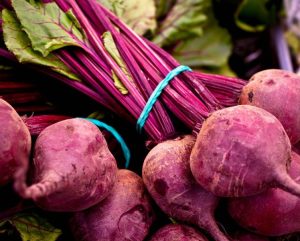 Beet, Red – Red beets are root vegetables known for their earthy flavor and vibrant red-purple color. They are rich in nutrients like folate, manganese, potassium, dietary fiber, and antioxidants such as betalains, which help reduce inflammation and support heart health. Both the roots and greens are edible, with the greens offering additional nutrients like vitamins A and C. Beets can be eaten raw in salads, roasted, boiled, or blended into smoothies and soups. Store beet greens separately from the root, wrapped in a damp cloth or in a plastic bag in the fridge. Use within a few days – they don’t keep long. Beetroots can be stored in a plastic bag in the fridge’s crisper drawer for up to two weeks. To freeze beets for longer storage, slice or chop them, spread on a cookie sheet to flash freeze, then transfer to freezer bags where they can be stored for up to a year.
Beet, Red – Red beets are root vegetables known for their earthy flavor and vibrant red-purple color. They are rich in nutrients like folate, manganese, potassium, dietary fiber, and antioxidants such as betalains, which help reduce inflammation and support heart health. Both the roots and greens are edible, with the greens offering additional nutrients like vitamins A and C. Beets can be eaten raw in salads, roasted, boiled, or blended into smoothies and soups. Store beet greens separately from the root, wrapped in a damp cloth or in a plastic bag in the fridge. Use within a few days – they don’t keep long. Beetroots can be stored in a plastic bag in the fridge’s crisper drawer for up to two weeks. To freeze beets for longer storage, slice or chop them, spread on a cookie sheet to flash freeze, then transfer to freezer bags where they can be stored for up to a year.
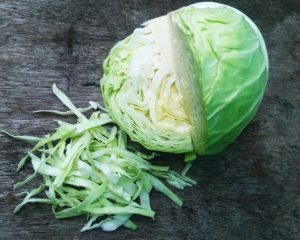 Cabbage, Green – Green cabbage is a nutrient-dense cruciferous vegetable in the Brassica family, known for its tightly packed, round, pale green leaves. It is rich in vitamins C and K, as well as fiber and antioxidants, which are beneficial for immune health, digestion, and bone strength. With a mild, slightly peppery taste, green cabbage can be enjoyed raw in salads and slaws, or cooked in stir-fries, soups, and stews. To store, keep green cabbage unwashed in a perforated plastic bag in the refrigerator’s crisper drawer, where it can stay fresh for up to two weeks.
Cabbage, Green – Green cabbage is a nutrient-dense cruciferous vegetable in the Brassica family, known for its tightly packed, round, pale green leaves. It is rich in vitamins C and K, as well as fiber and antioxidants, which are beneficial for immune health, digestion, and bone strength. With a mild, slightly peppery taste, green cabbage can be enjoyed raw in salads and slaws, or cooked in stir-fries, soups, and stews. To store, keep green cabbage unwashed in a perforated plastic bag in the refrigerator’s crisper drawer, where it can stay fresh for up to two weeks.
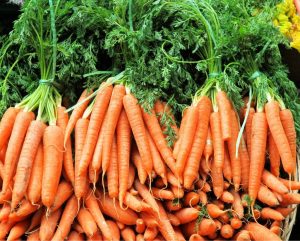 Carrot – Carrots are a versatile and popular root vegetable, known for their sweet, crunchy texture and vibrant orange color, though they can also be found in purple, yellow, and red varieties. They are rich in beta-carotene, which the body converts to vitamin A, essential for good vision and immune health. Carrots are a good source of dietary fiber, potassium, and antioxidants. Enjoy them raw, cooked, roasted, or juiced. They can be used in salads, soups, stews, and side dishes. For optimal storage, store carrots unwashed in the fridge, preferably in a plastic bag or container to maintain moisture, where they can last for several weeks. If the greens are attached, cut them off to prevent the carrots from becoming limp. Stored properly, they should last around 1-2 weeks.
Carrot – Carrots are a versatile and popular root vegetable, known for their sweet, crunchy texture and vibrant orange color, though they can also be found in purple, yellow, and red varieties. They are rich in beta-carotene, which the body converts to vitamin A, essential for good vision and immune health. Carrots are a good source of dietary fiber, potassium, and antioxidants. Enjoy them raw, cooked, roasted, or juiced. They can be used in salads, soups, stews, and side dishes. For optimal storage, store carrots unwashed in the fridge, preferably in a plastic bag or container to maintain moisture, where they can last for several weeks. If the greens are attached, cut them off to prevent the carrots from becoming limp. Stored properly, they should last around 1-2 weeks.

Carrot, Rainbow – In addition to the nutritional benefits above, rainbow carrots stand out from standard orange carrots with their vibrant colors—purple, yellow, red, and white—each offering unique nutritional benefits and distinct flavors. Purple carrots contain anthocyanins, powerful antioxidants linked to anti-inflammatory and heart-health benefits, with a slightly earthy, spicy taste. Yellow carrots are rich in lutein, which promotes eye health by protecting against macular degeneration and cataracts, and they have a mild, subtly sweet flavor. Red carrots contain lycopene, a potent antioxidant that supports heart health, reduces the risk of certain cancers, and helps protect skin from UV damage, with a richer, sweeter taste.
These colorful carrots are perfect for adding visual appeal to dishes and enhancing the taste profile, whether roasted to bring out their natural sweetness, or sliced raw for salads. Their distinct flavors can also add depth to juices and smoothies. The diverse hues, flavors, and nutrients of rainbow carrots make them perfect for garnishes or serving as part of a vegetable medley. Store rainbow carrots the same way you would store standard orange carrots.
 Celery – Celery is a crunchy, low-calorie vegetable known for its mild, slightly salty flavor. It is rich in vitamins K and C, folate, potassium, and fiber, supporting bone health, digestion, and hydration. Celery is often eaten raw as a snack, added to salads, or used as a base in soups, stews, and stir-fries. Store celery in the refrigerator, tightly wrapped in aluminum foil to retain its crispness, where it can stay fresh for up to two weeks. For longer storage, celery can be chopped and frozen.
Celery – Celery is a crunchy, low-calorie vegetable known for its mild, slightly salty flavor. It is rich in vitamins K and C, folate, potassium, and fiber, supporting bone health, digestion, and hydration. Celery is often eaten raw as a snack, added to salads, or used as a base in soups, stews, and stir-fries. Store celery in the refrigerator, tightly wrapped in aluminum foil to retain its crispness, where it can stay fresh for up to two weeks. For longer storage, celery can be chopped and frozen.
Don’t forget to use those celery greens! They’re a great addition to cooked beans, salads, eggs. Use leaves to make pesto or dry them and make your own parsley flakes, powder, or salt.
 Dandelion Greens – These nutrient-packed leafy greens are rich in vitamins A, C, and K, as well as calcium, iron, and antioxidants. Dandelion greens have more calcium, iron, and vitamin A per serving than spinach! Slightly bitter with a nutty undertone, they are great in salads, sautéed as a side dish, blended into smoothies or soups, or even used as a pizza topping. To store, keep them unwashed in a plastic bag or container lined with paper towels in the fridge, and use within 3–5 days for peak freshness.
Dandelion Greens – These nutrient-packed leafy greens are rich in vitamins A, C, and K, as well as calcium, iron, and antioxidants. Dandelion greens have more calcium, iron, and vitamin A per serving than spinach! Slightly bitter with a nutty undertone, they are great in salads, sautéed as a side dish, blended into smoothies or soups, or even used as a pizza topping. To store, keep them unwashed in a plastic bag or container lined with paper towels in the fridge, and use within 3–5 days for peak freshness.
Did you know? Dandelions weren’t always considered “weeds.” European settlers intentionally brought dandelions to North America because of their medicinal and nutritional benefits. Every part of the dandelion plant is edible – the greens, flowers, and roots have been used in cooking and medicine for centuries. The bitter compounds in dandelion greens have been used to stimulate digestion and support liver function. Roasted dandelion roots have a slightly nutty, earthy flavor and are used as a caffeine-free coffee alternative.
 Ginger – Ginger is a flavorful root widely used as a spice and natural remedy. It has a warm, slightly spicy taste and is rich in bioactive compounds like gingerol, which has anti-inflammatory and antioxidant properties. Ginger aids digestion, relieves nausea, and supports immune health. It is versatile in cooking and used in teas, curries, stir-fries, baked goods, and beverages. Store fresh ginger in a cool, dry place for short-term use or in the refrigerator in a paper towel or airtight bag for extended freshness. For long-term storage, freeze peeled or sliced ginger.
Ginger – Ginger is a flavorful root widely used as a spice and natural remedy. It has a warm, slightly spicy taste and is rich in bioactive compounds like gingerol, which has anti-inflammatory and antioxidant properties. Ginger aids digestion, relieves nausea, and supports immune health. It is versatile in cooking and used in teas, curries, stir-fries, baked goods, and beverages. Store fresh ginger in a cool, dry place for short-term use or in the refrigerator in a paper towel or airtight bag for extended freshness. For long-term storage, freeze peeled or sliced ginger.
Freeze your fresh ginger for longer storage: Peel and slice or grate the ginger. Freeze in an airtight container or ice cube tray. You can also freeze the whole unpeeled root in a freezer bag. Grate or slice directly from frozen as needed.
 Green Onions – Green onions, also known as scallions, have a mild, slightly sweet onion flavor and are packed with vitamins A and K. They are often used raw in salads, salsas, and garnishes but also add depth to stir-fries, soups, and omelets. Their green tops and white bulbs are both edible, making them a versatile ingredient. Store in the refrigerator, wrapped in a damp paper towel inside a bag, or stand them in a jar of water to keep them fresh longer.
Green Onions – Green onions, also known as scallions, have a mild, slightly sweet onion flavor and are packed with vitamins A and K. They are often used raw in salads, salsas, and garnishes but also add depth to stir-fries, soups, and omelets. Their green tops and white bulbs are both edible, making them a versatile ingredient. Store in the refrigerator, wrapped in a damp paper towel inside a bag, or stand them in a jar of water to keep them fresh longer.
 Kale (baby) – Compared to mature kale, baby kale has a milder flavor and more tender leaves, making it ideal for raw applications like salads or smoothies. Nutritionally, it retains the same benefits—rich in vitamins A, C, and K—but may have slightly lower fiber content due to its delicate structure. Store it in a sealed container with a dry paper towel in the fridge and use within a few days to prevent wilting.
Kale (baby) – Compared to mature kale, baby kale has a milder flavor and more tender leaves, making it ideal for raw applications like salads or smoothies. Nutritionally, it retains the same benefits—rich in vitamins A, C, and K—but may have slightly lower fiber content due to its delicate structure. Store it in a sealed container with a dry paper towel in the fridge and use within a few days to prevent wilting.
Mushroom Varieties
Store mushrooms in a paper bag or breathable container in the refrigerator, avoiding moisture buildup, and only wash them right before use to maintain freshness.
Mushrooms are super versatile in the kitchen. Here are 10 Things You Should Do With Mushrooms.
This roundup of 20 Mushroom Recipes has you covered with meal ideas for breakfast, lunch, or dinner.
Mushroom, Portobello & Cremini – Portobello mushrooms are mature versions of cremini mushrooms, offering a meaty texture and rich, earthy flavor. Cremini, also known as “baby bellas,” are younger, smaller, and have a firmer texture with a milder taste. Both are low in calories, fat-free, cholesterol-free, and provide B vitamins, selenium, potassium, and antioxidants. Portobellos are ideal for grilling, roasting, or as a meat substitute in burgers, sandwiches, or stuffed recipes. Creminis are great for sautéing, adding to soups, stir-fries, pasta dishes, or as pizza and salad toppings.
Mushroom, Lion’s Mane – Lion’s mane mushrooms are known for their shaggy, white appearance and mild, slightly sweet, seafood-like flavor. Rich in antioxidants, they contain compounds that may support brain health, nerve regeneration, and immune function. These mushrooms can be sautéed, roasted, or added to soups and stir-fries, often used as a meat substitute due to their tender, meaty texture. Store them in a paper bag in the fridge and use within a few days for the best texture and flavor.
💡Tip: The artisan mushroom sampler is a great way to try different varieties of mushrooms. While we can’t predict or guarantee what will be included, the sampler often includes varieties such as enoki, oyster, shiitake, or trumpet mushrooms!
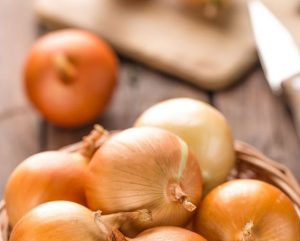
Onion, Yellow – Yellow onions are a popular, versatile vegetable with golden-brown skin and a strong, savory flavor that mellows and sweetens when cooked. Rich in antioxidants, vitamin C, and fiber, yellow onions support immune health, digestion, and overall cellular health. They’re a staple in many cuisines, perfect for sautéing, caramelizing, roasting, and adding depth to soups, stews, and sauces. To store, keep unpeeled yellow onions in a cool, dry, well-ventilated place, away from potatoes, where they can last up to a month; once peeled or cut, store them in an airtight container in the refrigerator for up to a week.
 Parsnip – Parsnips are root vegetables with pale, creamy skin and a sweet, nutty flavor, especially when cooked. They are high in fiber, vitamin C, and folate, which promote digestion, immune health, and cell function. Parsnips are great roasted, mashed, added to soups, or used as a potato substitute. Parsnips can be spiralized into veggie noodles or blended into creamy soups for a subtly sweet, earthy flavor. Their natural sweetness also makes them a great addition to baked goods like muffins or cakes. Store unwashed parsnips in the refrigerator crisper drawer, where they can last for two to three weeks.
Parsnip – Parsnips are root vegetables with pale, creamy skin and a sweet, nutty flavor, especially when cooked. They are high in fiber, vitamin C, and folate, which promote digestion, immune health, and cell function. Parsnips are great roasted, mashed, added to soups, or used as a potato substitute. Parsnips can be spiralized into veggie noodles or blended into creamy soups for a subtly sweet, earthy flavor. Their natural sweetness also makes them a great addition to baked goods like muffins or cakes. Store unwashed parsnips in the refrigerator crisper drawer, where they can last for two to three weeks.
Tip: Add parsnips to baked goods like muffins or cakes for a mild sweetness and extra moisture, similar to how carrots are used in carrot cake. Parsnips tend to be sweeter during winter, as the cold converts their starches into natural sugars.
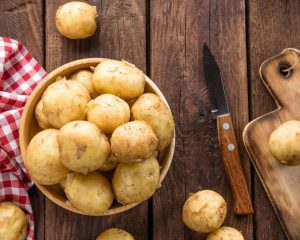 Potato, Yellow – Also known as Yukon Gold or gold potatoes, yellow potatoes have smooth, thin, yellowish skin and creamy, buttery-flavored flesh. They are slightly waxy, making them versatile in cooking. Yellow potatoes are a good source of vitamin C, potassium, and fiber and are low in calories and fat. Their creamy texture makes them ideal for mashing, roasting, grilling, and boiling. They are also excellent in gratins and salads because they hold shape during cooking. Store yellow potatoes in a cool, dark, and well-ventilated place for several weeks, avoiding refrigeration as it can alter their texture and flavor.
Potato, Yellow – Also known as Yukon Gold or gold potatoes, yellow potatoes have smooth, thin, yellowish skin and creamy, buttery-flavored flesh. They are slightly waxy, making them versatile in cooking. Yellow potatoes are a good source of vitamin C, potassium, and fiber and are low in calories and fat. Their creamy texture makes them ideal for mashing, roasting, grilling, and boiling. They are also excellent in gratins and salads because they hold shape during cooking. Store yellow potatoes in a cool, dark, and well-ventilated place for several weeks, avoiding refrigeration as it can alter their texture and flavor.
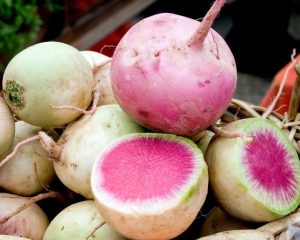 Radish, Watermelon – Watermelon radish is a striking root vegetable with a mild, slightly sweet flavor and a crisp texture. Its pale green skin hides a vibrant pink interior, resembling a watermelon. Rich in vitamin C, potassium, and antioxidants, it supports immune health and reduces inflammation. Watermelon radishes can be enjoyed raw in salads, sliced thinly for garnishes, pickled, or roasted for a milder flavor. Store unwashed watermelon radishes in a perforated plastic bag in the refrigerator, where they can stay fresh for up to two weeks. Wash and trim just before using.
Radish, Watermelon – Watermelon radish is a striking root vegetable with a mild, slightly sweet flavor and a crisp texture. Its pale green skin hides a vibrant pink interior, resembling a watermelon. Rich in vitamin C, potassium, and antioxidants, it supports immune health and reduces inflammation. Watermelon radishes can be enjoyed raw in salads, sliced thinly for garnishes, pickled, or roasted for a milder flavor. Store unwashed watermelon radishes in a perforated plastic bag in the refrigerator, where they can stay fresh for up to two weeks. Wash and trim just before using.
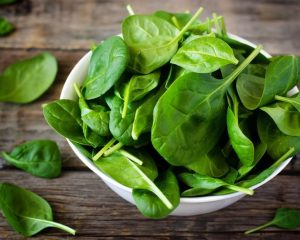 Spinach – Spinach is a nutrient-rich leafy green vegetable packed with vitamins A, C, K, and folate, along with minerals like iron and magnesium. Low in calories and high in antioxidants, it supports eye health, bone strength, and immune function. Spinach is versatile and can be enjoyed raw in salads, blended into smoothies, or cooked in soups, pasta, and omelets. To store, keep it dry in a perforated plastic bag in the fridge’s crisper drawer, and wash only before use. Properly stored, it stays fresh for 5-7 days.
Spinach – Spinach is a nutrient-rich leafy green vegetable packed with vitamins A, C, K, and folate, along with minerals like iron and magnesium. Low in calories and high in antioxidants, it supports eye health, bone strength, and immune function. Spinach is versatile and can be enjoyed raw in salads, blended into smoothies, or cooked in soups, pasta, and omelets. To store, keep it dry in a perforated plastic bag in the fridge’s crisper drawer, and wash only before use. Properly stored, it stays fresh for 5-7 days.
 Sweet Potato – Sweet potatoes are a nutritious root vegetable known for their naturally sweet flavor and vibrant orange flesh, though they also come in other colors like purple and white. They are rich in vitamins A (as beta-carotene), C, and B6, as well as dietary fiber, potassium, and antioxidants. These nutrients support eye health, boost immunity, and promote digestive health. Sweet potatoes are versatile in cooking and can be baked, roasted, mashed, or used in soups and stews. They can also be enjoyed in both savory and sweet dishes. Store sweet potatoes in a cool, dark, well-ventilated place for several weeks, avoiding refrigeration as it can affect their texture and flavor.
Sweet Potato – Sweet potatoes are a nutritious root vegetable known for their naturally sweet flavor and vibrant orange flesh, though they also come in other colors like purple and white. They are rich in vitamins A (as beta-carotene), C, and B6, as well as dietary fiber, potassium, and antioxidants. These nutrients support eye health, boost immunity, and promote digestive health. Sweet potatoes are versatile in cooking and can be baked, roasted, mashed, or used in soups and stews. They can also be enjoyed in both savory and sweet dishes. Store sweet potatoes in a cool, dark, well-ventilated place for several weeks, avoiding refrigeration as it can affect their texture and flavor.
 Sweet Potato, Fingerling – Sweet potato fingerlings are small, slender sweet potatoes with thin, edible skin and a naturally sweet, creamy texture. They are rich in fiber, beta-carotene, and vitamin C, promoting digestive and immune health. Roast, sauté, or air-fry them whole for a crispy skin and tender interior, or slice them into fries or hash. Store in a cool, dry place away from light, but avoid refrigeration as it can affect their texture.
Sweet Potato, Fingerling – Sweet potato fingerlings are small, slender sweet potatoes with thin, edible skin and a naturally sweet, creamy texture. They are rich in fiber, beta-carotene, and vitamin C, promoting digestive and immune health. Roast, sauté, or air-fry them whole for a crispy skin and tender interior, or slice them into fries or hash. Store in a cool, dry place away from light, but avoid refrigeration as it can affect their texture.
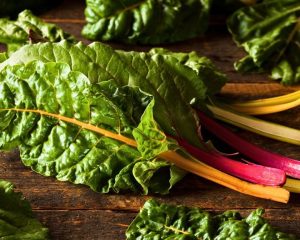 Swiss Chard – Swiss chard is a vibrant leafy green vegetable, rich in vitamins A, C, and K, as well as magnesium, potassium, and iron, making it a nutritious, low-calorie option. The stems come in various colors or simply a whitish green. Both the leaves and the stalks are edible. When picked very young, chard can be part of a green salad. But full-grown chard like in your box today has a very strong flavor and tough stems when eaten raw. Its slightly bitter, earthy flavor pairs well with garlic, lemon, and olive oil, and it can be sautéed or steamed. After cooking for several minutes, it can also be added to rice and beans or omelets. Chard can be sliced or chopped and added to soups. The stems work well in soups, stews, or as a celery substitute. Use Chard any way you would prepare spinach, allowing for longer cooking time for the stems. To store, keep unwashed in a plastic bag or container in the refrigerator’s crisper drawer, using it within 3–5 days; if it wilts, revive it by soaking in cold water before use. Before using, wash well in cool water and separate the leaves from the stems.
Swiss Chard – Swiss chard is a vibrant leafy green vegetable, rich in vitamins A, C, and K, as well as magnesium, potassium, and iron, making it a nutritious, low-calorie option. The stems come in various colors or simply a whitish green. Both the leaves and the stalks are edible. When picked very young, chard can be part of a green salad. But full-grown chard like in your box today has a very strong flavor and tough stems when eaten raw. Its slightly bitter, earthy flavor pairs well with garlic, lemon, and olive oil, and it can be sautéed or steamed. After cooking for several minutes, it can also be added to rice and beans or omelets. Chard can be sliced or chopped and added to soups. The stems work well in soups, stews, or as a celery substitute. Use Chard any way you would prepare spinach, allowing for longer cooking time for the stems. To store, keep unwashed in a plastic bag or container in the refrigerator’s crisper drawer, using it within 3–5 days; if it wilts, revive it by soaking in cold water before use. Before using, wash well in cool water and separate the leaves from the stems.

Swiss Chard (baby) – Milder and more tender than mature Swiss chard, baby chard is often used raw in salads, wraps, or grain bowls. While still rich in vitamins A, C, and K, it may have slightly less fiber than its fully grown counterpart. Store in a sealed container with a dry paper towel in the fridge and use within 3–5 days for the best freshness.
Fun fact: Chard is in the chenopod family which includes beets, spinach, and quinoa.
Don’t Forget: Online shopping opens Friday at 1 PM! 🛒 Stock your kitchen with these clean, nourishing ingredients to fuel your family with nutrient-dense meals. Be sure to grab your favorite staples and try something new for vibrant health this winter.
Don’t wait to join…
Veggie E-Books
Download these collections of tips and recipes for each veggie. You’ll use these as a reference throughout the season.
Beets E-Book
Carrots E-Book
Kale E-Book
Mushrooms E-Book
Onions E-Book
Potatoes E-Book
Radish E-Book
Scallion/Green Onion E-Book
Spinach E-Book
Swiss Chard E-Book
~~~~~
Farm News and Events
We’ll keep farming for you!
Reuben and Tessa DeMaster
Willow Haven Farm


